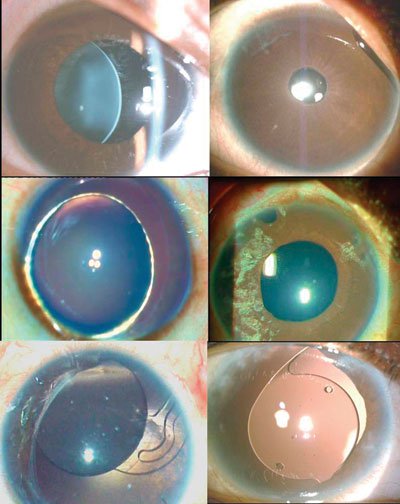Study finds reasonable results with glued IOL in pediatric eyes
Refractive changes in these young growing eyes can be problematic.
 Amar Agarwal |
Pediatric eyes differ from adult eyes due to their rapid growth and significant refractive changes in early childhood. Hence, IOL implantation after cataract surgery in these eyes should be matched to the growing and changing refraction. IOL implantation in eyes with large posterior capsular rent or ectopia lentis becomes further complicated due to lack of normal capsular support.
Anterior chamber IOLs and scleral-fixated IOLs are options that have shown variable results. We have performed transscleral IOL fixation with fibrin glue (glued IOL technique) in adult eyes with deficient capsules with reasonable results. Here we discuss the procedure in pediatric eyes.
Results
Forty-one eyes of 33 children underwent glued IOL implantation. The mean patient age was 10.17 ± 4 years. The mean follow-up was 17.5 ± 8.5 months. Fifteen eyes had aphakia, 14 had congenital subluxated cataract, nine had ectopia lentis, two had traumatic subluxation and one had IOL decentration. The mean uncorrected visual acuity was 0.04 ± 0.05 preoperatively and 0.25 ± 0.21 postoperatively. There was significant improvement in UCVA (P = .000) after implantation. The postoperative mean best corrected visual acuity was 0.43 ± 0.33, and there was significant change in BCVA (P = .000).
There were 22 rigid IOLs and 19 foldable IOLs in our series. The mean endothelial cell density was 2,411 ± 355.6 cells/mm2 preoperatively and 2,311.8 ± 345.4 cells/mm2 postoperatively. The mean corneal endothelial loss was 4.13%. Postoperative 20/20 vision was obtained in 17% of the eyes. BCVA better than 20/60 was obtained in 41.4% of eyes. The mean postoperative spherical equivalent was –0.25 ± 1.1 D. Good IOL centration was clinically seen in all eyes at the last follow-up examinations (Figure).
 Preoperative clinical photograph of lens subluxation (top left) and 2 years postoperative (top right). Preoperative clinical photograph of eye with total subluxated lens with spherophakia (middle left) and 3 years postoperative (middle right). Preoperative clinical photograph of eye with decentered scleral-fixated IOL (bottom left) and 3 years postoperative (bottom right). Images: Agarwal A |
Discussion
The choice of IOL implantation in deficient capsules is challenging, especially in children. Pediatric aphakia due to cataract surgery treated by contact lens or spectacle correction shows poor compliance. Hence, IOL implantation is recommended in all pediatric eyes at younger ages.
Secondary IOL implantation in post-cataract aphakia with anterior chamber IOLs is cumbersome. They can induce recurrent uveitis, especially with a growing anterior chamber, and can cause endothelial decompensation. However, recent advances in anterior chamber IOL design have yielded lenses that provide a safe, effective alternative to sutured posterior chamber IOLs. However, some eyes, such as those with aniridia in which anterior chamber IOLs cannot be placed, the glued IOL technique can be performed.
Another alternative in these eyes is the sutured scleral-fixated IOL. Scleral fixation of a posterior chamber IOL with 10-0 Prolene sutures has long-term side effects due to suture degradation. Suture inflammation, loose sutures or broken sutures can lead to malposition of the IOL. The glued IOL technique does not have such suture-related complications associated with scleral-fixated IOLs. Moreover, with foldable IOLs, the chances of suture-induced astigmatism are decreased and early visual rehabilitation is observed. It causes less pseudophakodonesis as compared with IOLs sutured to the sclera with 10-0 Prolene. There is no need for a new-design IOL because the same posterior chamber IOL, rigid or foldable, can be used for this method.
Refraction
Another problem comes with IOL power calculations in the growing pediatric eye, as the chance of shift in refraction is known to occur. SRK II formulas have shown to give predictable refraction and have been used for IOL power calculation. It is known that the greatest rate of refractive growth or change occurs between 1 and 3 years of age. After 3 years, the rate of refractive growth follows a more linear trend. But even after targeting emmetropia, it may be difficult to get plano due to the change in pattern of growth.
In our study, the mean postoperative refraction was not high (myopic shift was –1.1 D and hyperopic shift was 1 D) on mean follow-up of 17.5 months. Limitations include that target emmetropia was not attainable due to change in refractive status of the eye, which may need further study regarding the IOL power calculation, and moreover, we have not reported the outcomes in children younger than 5 years. Nevertheless, this method of IOL implantation has shown reasonable interim results in children; long-term follow-up is required to confirm the functional outcome in these growing eyes.

- Amar Agarwal, MS, FRCS, FRCOphth, is director of Dr. Agarwal’s Eye Hospital and Eye Research Centre. Prof. Agarwal is the author of several books published by SLACK Incorporated, publisher of Ocular Surgery News, including Phaco Nightmares: Conquering Cataract Catastrophes, Bimanual Phaco: Mastering the Phakonit/MICS Technique, Dry Eye: A Practical Guide to Ocular Surface Disorders and Stem Cell Surgery and Presbyopia: A Surgical Textbook. He can be reached at 19 Cathedral Road, Chennai 600 086, India; fax: 91-44-28115871; email: dragarwal@vsnl.com; website: www.dragarwal.com.
- Disclosure: No products or companies are mentioned that would require financial disclosure.
